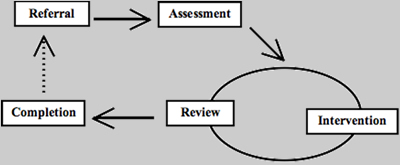Room 3 - Delivery Room (Section 1 of 12)
The delivery cycle
In order to better understand the processes that might be involved in the delivery of mobility and independence education, we developed a cyclical model of service delivery based upon a well-known concept often used in educational research.
Bozic and Murdoch (1996) used a similar cyclical model in their study of the use of educational technology that consisted of four stages, namely: aims, planning, review and interaction. We further developed this model to include entry into the system (referral), the design of a sui mobility and independence programme (programme design), and possible exit from the system (completion), so that the stages of the delivery cycle included: referral, assessment, programme design, intervention, review and completion (see Fig. 1).
Fig.1 Cyclical model of service delivery showing six stages of delivery

This framework provided a structure for exploring the various stages of delivery, the collection of data relevant to each stage, and for subsequent analysis of the data collected.
In each stage then, there were a number of factors to investigate, namely: who is involved, how they are involved and when, and what procedures are followed. In particular, we wanted people’s views on what actually happened in each stage, what difficulties might be encountered, and how these difficulties were or could be overcome. From this data, we would be able to make recommendations regarding service delivery, based on the accounts and opinions given by the people that were involved in the field. Since these recommendations would be based upon the actual data collected, any recommendations would hopefully reflect the needs of and be relevant to the very people they were being aimed at.
Other considerations affecting delivery
In this section we identify further ways that key mobility and independence skills can be delivered within and beyond the school curriculum. We present details of key issues that were identified which must be considered by those responsible for providing mobility and independence education. These include particular reference to pre-school children, post-school provision, children with MDVI, and issues of cultural and religious background. Specific and practical recommendations based upon good practice are made for each.
What was happening in the UK in 2000?
Findings from our research demonstrate that a variety of agencies and mechanisms are employed across the UK to deliver the mobility and independence curriculum. During the research, a total of 51 interviews were conducted with a variety of professionals involved in mobility and independence delivery. At least one interview (usually more) was carried out in nine of the eleven educational regions in England, plus interviews in Scotland and Wales (six). The 51 interviews represented 29 different ‘mobility and independence services’.
The table below shows a breakdown of the main provider involved in each of the 29 different mobility and independence services to mainstream education:
Table 1: Summary of main provider in 29 mobility and independence services to mainstream education
| Provider | Number of M&I services | Percentage % |
|---|
| L E A* |
17 |
59 |
| Social Services |
6 |
21 |
| Voluntary Organisation |
5 |
17 |
| Outside consultant |
1 |
3 |
| Total |
29 |
100 |
*The LEA employed MIE may be a QTVI with an additional qualification in mobility and independence, or a qualified professional whose main or sole role is to provide mobility and independence. Refer to Section 1 of the M&I Policy & Service Room for further explanation.
The picture is more complex than the table suggests however, since there is often more than one agency involved. While the ‘main provider’ can be defined as the agency delivering the majority of mobility and independence education, many work alongside another agency involved in the delivery of particular aspects of the mobility and independence curriculum (see Section 3 of the M&I Policy & Service Room for further discussion about this). Examples of criteria for the division of provision include:
Mobility and independence curriculum area, e.g. independent living skills provided by a single agency
Location, e.g. the delivery of mobility and independence education in a particular locality such as in/around school mobility and independence provided by education and home area/out of school mobility and independence provided by social services or a voluntary organisation
Time, e.g. education mobility and independence educator provides support within school time whilst social services mobility and independence educator provides support after school and/or in the holidays
Clearly the models of provision employed in different parts of the country vary enormously. Most notably, other agencies beyond the LEA support service are often involved, and interviews were used to gain a more detailed picture of how mobility and independence education is provided in these different settings. This illustrated that among those interviewed, inter-agency provision of mobility and independence education is very common.
It should be noted that these findings are drawn from the sample of participants who opted into the research, and may not therefore be a complete picture of national provision.
Activity 1
Make a list of agencies that are involved in providing M&I education to mainstream schools in either your own service, or a service known to you.
If there is more than one agency involved, consider how different aspects of provision are demarcated, and who is involved in the decision making process.
You may also wish to reflect upon the relative advantages and disadvantages of involving different agencies in M&I education for children attending mainstream schools. These issues are covered in more detail in the M&I Policy & Service Room.
References
Bozic, N. and Murdoch, H. (Eds), (1996). Learning Through Interaction: Technology and Children with Multiple Disabilities. London: David Fulton Publishers Ltd.
Previous Section - Next Section